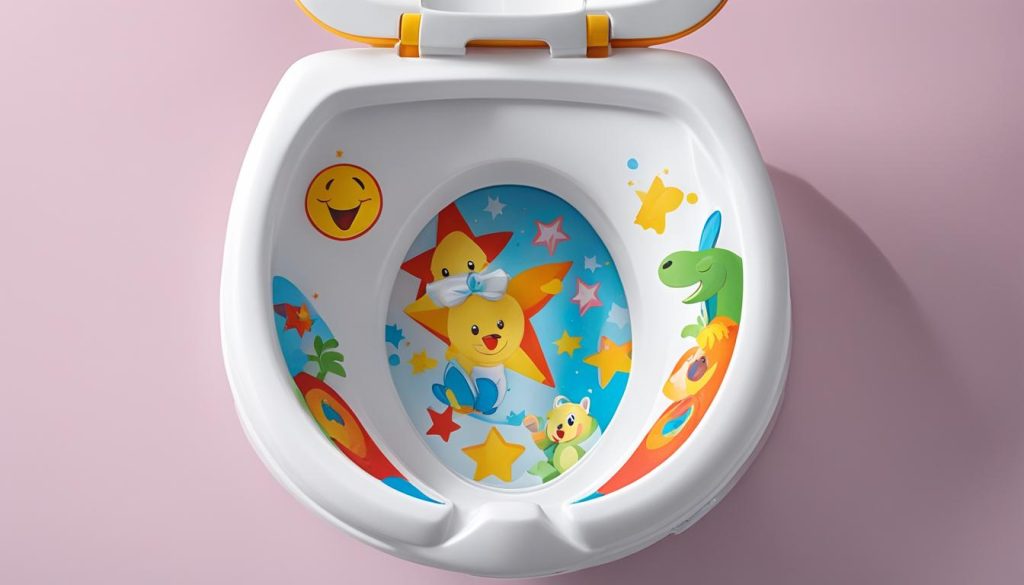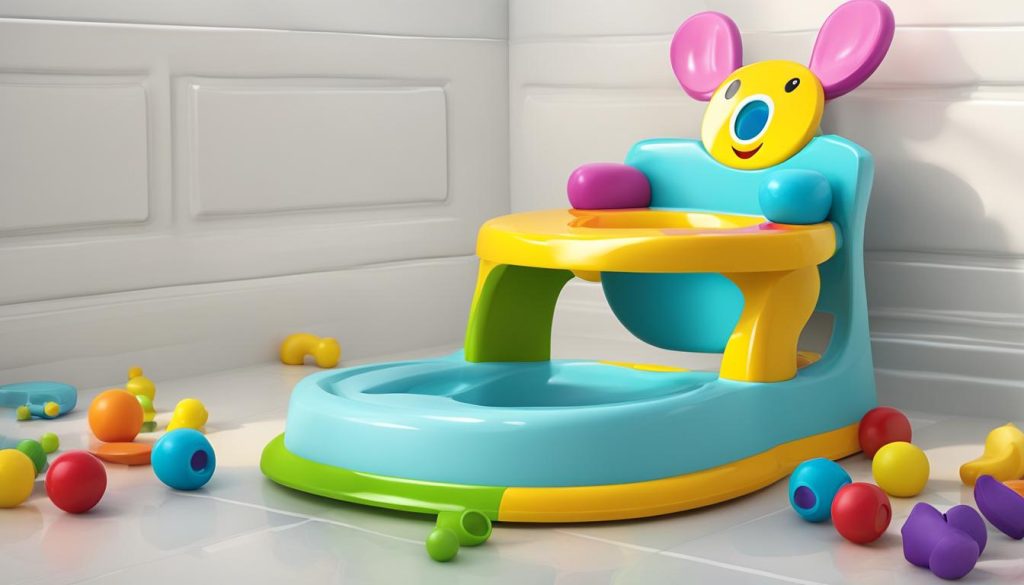Potty training is an important milestone for toddlers and parents, but it can come with a lot of messes. Cleaning your baby’s potty seat is essential for maintaining hygiene and ensuring your child’s comfort and safety. In this section, I will share some easy cleaning tips and techniques to keep your baby potty seat clean and germ-free.
When it comes to cleaning your baby potty seat, there are a few easy ways to ensure it stays clean and hygienic. Firstly, make sure to remove any waste from the seat using disposable gloves or a toilet tissue. Next, rinse the seat thoroughly with warm water to remove any residue. You can also use a mild soap or baby-friendly cleaning solution to help break down any stubborn stains.
Once you’ve cleaned the seat, it’s important to dry it properly to prevent the growth of bacteria. You can either air dry it or use a clean cloth to wipe it dry. Remember to clean the seat regularly, ideally after every use, to maintain its cleanliness and prevent any odors.
By following these easy cleaning tips, you can ensure that your baby potty seat stays clean and free from germs. A clean potty seat is not only important for your child’s health, but it also promotes a positive potty training experience.
Stay tuned for the next section where I will discuss the different types of baby potty seats and how to choose the right one for your child.
Understanding Different Types of Baby Potty Seats
When it comes to potty training your child, choosing the right baby potty seat is essential for their comfort and successful transition. There are two main types of baby potty seats to consider: potty chairs and potty seats that fit over the regular toilet seat.
1. Potty Chairs:
Potty chairs are standalone units that are smaller in size and often come in bright, colorful designs that appeal to toddlers. They have a removable bowl that can be easily emptied and cleaned. Potty chairs are ideal for younger children who may feel more secure and comfortable on a smaller, more stable seat.
2. Potty Seats:
Potty seats are designed to fit directly over the regular toilet seat, providing a transition for your child to use the adult toilet. They come in various designs and styles, offering features like handles and non-slip surfaces for added safety. Potty seats are a more practical option for older children who are ready to use the regular toilet.
Choosing the right potty seat depends on your child’s age, size, and readiness for potty training. Some children may prefer the independence and familiarity of a potty chair, while others may be eager to mimic their parents and use a potty seat. It’s important to consider your child’s preferences and comfort when making your decision.
Comparison Table: Potty Chair vs. Potty Seat
| Potty Chair | Potty Seat |
|---|---|
| Smaller and more colorful | Fits over the regular toilet seat |
| Standalone unit | Requires adult toilet |
| Removable bowl for easy cleaning | No additional cleaning required |
| Offers stability for younger children | Provides transition to the adult toilet |
Remember, every child is different, and what works for one may not work for another. It’s important to consider your child’s needs and preferences when selecting a potty seat. With the right type of baby potty seat, you can create a positive and successful potty training experience for your child.
Step-by-Step Guide on How to Clean a Baby Potty Seat
Cleaning a baby potty seat is an essential task to maintain hygiene and keep your child safe during their potty training journey. By following these step-by-step instructions, you can effectively clean your baby’s potty seat:
Gather the necessary materials:
- Mild soap or baby-friendly cleaning solution
- Soft-bristle brush or sponge
- Disposable gloves (optional)
- Disinfectant spray or wipes
- Paper towels or clean cloth
Step 1: Start by removing any solid waste from the potty seat. You can use toilet paper or a small scoop to ensure proper disposal. If needed, wear disposable gloves for added cleanliness.
Step 2: Rinse the potty seat with warm water to remove any residue. Use a soft-bristle brush or sponge to gently scrub the seat, ensuring you reach all the nooks and crannies.
Step 3: Apply mild soap or a baby-friendly cleaning solution to the potty seat. Thoroughly clean the seat using the brush or sponge, focusing on areas that may have come into contact with urine or feces.
Step 4: Rinse the potty seat again with warm water to remove any soap residue. Make sure all traces of cleaning solution are washed away.
Step 5: Use a disinfectant spray or wipes to sanitize the potty seat. Follow the instructions on the product for the recommended contact time to effectively kill germs and bacteria.
Step 6: Dry the potty seat thoroughly with paper towels or a clean cloth. Ensure there is no moisture left, as it can promote the growth of mold or mildew.
By following these simple steps, you can keep your baby’s potty seat clean and germ-free, providing a hygienic environment for their potty training journey.
Table: Comparison of Cleaning Methods
| Cleaning Method | Advantages | Disadvantages |
|---|---|---|
| Using mild soap | – Effective in removing dirt and grime – Safe for baby’s sensitive skin |
– Requires thorough rinsing to avoid residue – May not effectively eliminate all germs |
| Baby-friendly cleaning solution | – Specifically formulated for baby products – Provides added disinfection |
– Some solutions may contain strong odors – Can be more expensive than regular soap |
| Disinfectant wipes/spray | – Quick and convenient – Kills a wide range of germs |
– May contain harsh chemicals – Should be used in a well-ventilated area |
Tips for Maintaining a Clean and Hygienic Baby Potty Seat
Ensuring that your baby’s potty seat is clean and germ-free is crucial for their health and well-being. Here are some practical tips to help you maintain a clean and hygienic baby potty seat:
- Regular Cleaning: It is important to clean the potty seat after every use. Start by wiping off any visible waste using toilet paper or a wet wipe. Then, wash the seat with warm soapy water, making sure to scrub all the nooks and crannies. Rinse thoroughly to remove any soap residue.
- Disinfectant Cleaners: Regularly disinfecting the potty seat is essential for eliminating bacteria and germs. You can use a mild disinfectant cleaner or a mixture of water and vinegar. Spray the solution onto the seat and let it sit for a few minutes before wiping it off.
- Proper Storage: After cleaning, it is important to store the potty seat in a clean and dry place. Avoid storing it near other items that may have bacteria or odors. Consider using a designated storage bag or container to keep it protected.
- Hygiene Practices: In addition to cleaning the potty seat, there are a few hygiene practices to follow. Teach your child proper handwashing techniques after using the potty seat. Encourage them to wash their hands with soap and water for at least 20 seconds.
By following these tips, you can maintain a clean and germ-free baby potty seat, ensuring a healthy and hygienic potty training experience for your little one.
Key takeaways:
– Regularly clean the potty seat using warm soapy water
– Disinfect the potty seat to eliminate bacteria and germs
– Store the potty seat in a clean and dry place
– Teach your child proper handwashing techniques after using the potty seat
Remember, maintaining a clean baby potty seat is an important part of potty training. By keeping it clean and hygienic, you can ensure your child’s well-being and create a positive potty training experience.
Conclusion
In conclusion, maintaining a clean and hygienic baby potty seat is crucial for your child’s health and well-being during the potty training journey. By following the easy cleaning tips and techniques outlined in this article, you can ensure that your child’s potty seat remains germ-free and comfortable.
Remember to choose the right type of potty seat for your child, whether it’s a potty chair or a seat that fits over the regular toilet. Each type has its pros and cons, so consider your child’s preferences and needs when making a decision.
Additionally, the step-by-step guide provided will help you effectively clean your baby’s potty seat. From removing waste to using disinfectant cleaners and proper drying techniques, these steps will streamline the cleaning process.
Lastly, maintaining proper hygiene practices, such as regular washing and using disinfectant cleaners, is essential. By following these tips and techniques, you can create a clean and hygienic environment for your child’s potty training experience. Make this journey a positive one for both you and your child!





